Publications:Newsletters/Oct2016: Difference between revisions
mNo edit summary |
|||
| Line 1: | Line 1: | ||
{{DISPLAYTITLE:CIRP October 2016 eNewsletter}} | |||
<span style="font-size:20px">Recent Advances in Coastal Inlet Navigation and Adjacent Beach Research</span> | <span style="font-size:20px">Recent Advances in Coastal Inlet Navigation and Adjacent Beach Research</span> | ||
<hr> | <hr> | ||
Latest revision as of 20:48, 25 August 2020
Recent Advances in Coastal Inlet Navigation and Adjacent Beach Research
Issue 38, Fall 2016
Dear Colleagues,
This message transmits the Coastal Inlets Research Program (CIRP) biannual email newsletter. The CIRP is a HQ Navigation and Operations Branch R&D Program with the mission of providing information and technology to reduce the cost of operation and maintenance of Federal coastal inlets, while treating the navigation project and adjacent beaches and estuary as a sediment-sharing system. This eNewsletter contains single paragraphs describing selected recent activities in the CIRP.
For feedback and suggestions on the newsletter, or for contributing a paragraph, please contact me.
For the CIRP investigators,
Julie Rosati
Julie.D.Rosati@usace.army.mil
CIRP Program Manager
In this Newsletter:
District Proponents will Champion FY17 Statements of Need
Happy New Fiscal Year from CIRP! CIRP researchers have planned our FY17 research to address existing and new Statements of Need (SoN) as submitted by District engineers and scientists. In FY17, we will be asking District proponents to help us define the research needed to address each SoN, evaluate our advancements through the research over a 2-3 year period, and help define delivery of the final research guidance in the form of engineering manuals, other documentation, and technology transfer. If you are interested in serving on a Product Delivery Team (PDT) for any of the CIRP research, please contact the researchers or myself directly. We envision needing your expertise on the order of 1-2 hours per quarter, to discuss progress and plans with you and get your input. CIRP research topics planned for FY17 are listed below. We look forward to working with you!
- Developing mixed-sized sediment transport numerical libraries
- Long-term morphology change of coastal inlets, bays, and adjacent beaches
- Verification & Validation of CMS in the Coastal Model Test Bed with data from the Field Research Facility
- Advancing surf and swash zone process calculations in nearshore models
- Tools for Eulerian sediment mapping in the Coastal Modeling System (CMS)
- Planning and engineering tools to calculate coastal inlet breaching, evolution, and closure
- Integration of the Corps Shoaling Analysis Tool (CSAT) with Channel Portfolio Tool (CPT)
- Advancements of the Automated Information System Analysis Package (AISAP)
- Guidance and tools for nearshore berm design & placement
- Advancements in the regional shoreline and inlet sand-sharing model, GenCade
- Resilience of coastal foredunes
- Engineering tools for vessel wake estimation and associated bank erosion
- Refinement and technology transfer of Meteorological Oceanographic (MetOcean) tools, WaveNet and TideNet
- Advancing wave models to include engineering design calculations for rubblemound navigation structures
POC: (ERDC) Julie Rosati, Julie.D.Rosati@usace.army.mil
Training with CIRP Products
If you are interested in training with CIRP products, there are several mechanisms. First, check the CIRP website for guidance documents and pre-recorded training segments. Next, consider submitting a Dredging Operations and Technical Support (DOTS) request for training on one or more CIRP and other Navigation-related tools and models here: https://dots.el.erdc.dren.mil/ . DOTS support is limited to cover approximately 2-weeks of an ERDC researcher’s time. If your training needs are more extensive, please contact CIRP researchers or Julie Rosati to discuss how we can leverage our planned technology transfer to support your work. In FY16, CIRP conducted 17 workshops and webinars, including five webinars and two in-person workshops. Below is highlighted one of the CIRP webinar series conducted during the last half of FY16. For questions about training opportunities, please contact Julie Rosati.
POC: (ERDC) Julie Rosati, Julie.D.Rosati@usace.army.mil
WaveNet and TideNet Webinars, April 2016
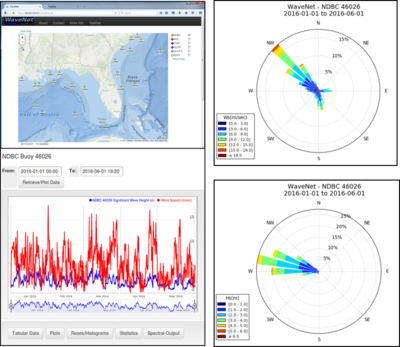
Two web-based tools developed by the Coastal Inlets Research Program (CIRP) were demonstrated by Drs. Zeki Demirbilek and Lihwa Lin in a series of four webinars on 19-22 April 2016. WaveNet and TideNet are the first two modules of the MetOcnDat (Meteorological and Oceanographic Data or Metocean data) management and analysis system. These tools help USACE users to access, analyze, and visualize metocean data for application to coastal navigation and storm damage reduction projects. Wave and wind data from six data sources can be accessed by WaveNet. These include data from the National Data Buoy Center, Wave Information Studies, Coastal Data Information Program, Great Lakes Observing System, Great Lakes Coastal Forecasting System, and WaveWatch III. TideNet provides water level data from four sources, including ADCIRC Tidal database, Le Provost Global Tidal database, National Ocean Service Tides and Currents, and Oregon State University TOPEX/Poseidon Global Model Ocean Tides. The WaveNet and TideNet tools can be accessed via the CIRP website http://cirp.usace.army.mil/products/wavenet.php. Attendees from 12 Districts and two ERDC labs participated in the webinar series. Future research needs, and additional data display, plot and analyses capabilities were identified. Archives of the webinars are available for viewing at any time from the CIRP website: http://cirp.usace.army.mil/techtransfer/webinars/2016-19Apr-webinar.php.
POC: (ERDC) Zeki Demirbilek, zeki.demirbilek@usace.army.mil
POC: (ERDC) Lihwa Lin, lihwa.lin@usace.army.mil
Sediment Mobility Tool for Nearshore Berms
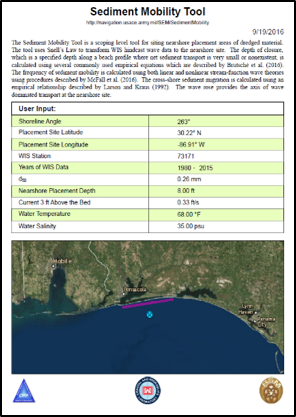
In FY16, the Inlet Geomorphology w.u., along with the Regional Sediment Management (RSM) program, created the Sediment Mobility Tool Web Application. The web application allows the user to site potential nearshore placement locations and estimates the frequency of sediment mobility as well as general transport direction. The results given from the web application can be used by District engineers and planners to assist in addressing any stakeholders and resource agencies concerns that may arise regarding transport of the material once placed in the nearshore. The tool will be available on the Navigation Portal (https://navigation.usace.army.mil), under the Dredging and Sediment & Ecosystem Management tabs. To help validate the tool and gain insights into nearshore placement morphological evolution, field data collection began at two sites in FY16 and will continue into FY17: Fort Myers Beach, Florida and Sand Island, Mississippi.
POC: (ERDC)Brian C. McFall, Brian.C.McFall@usace.army.mil
POC: (ERDC)Katherine Brutsché, Katherine.E.Brutsche@usace.army.mil
Dr. Brian McFall's PhD Research on Tsunamis Published in Proceedings of the Royal Society

Dr. McFall published a journal article titled “Physical modelling of tsunamis generated by three-dimensional deformable granular landslides on planar and conical island slopes” in the Proceedings of the Royal Society-A with Dr. Hermann Fritz of Georgia Tech University. Tsunamis generated by landslides and volcanic island collapses account for some of the most catastrophic events recorded, yet critically important field data related to the landslide motion and tsunami evolution remain lacking. Landslide generated tsunami source and run up scenarios were physically modeled using a unique pneumatic landslide tsunami generator to simulate landslides with varying geometry and kinematics in a three-dimensional wave basin. The landslides were generated on planar and conical island slopes to study lateral hill slope effects on the wave properties. Predictive equations for the offshore propagating wave characteristics were derived allowing an initial rapid tsunami hazard assessment. A photo of the model was chosen for the journal cover because of the scale. It is the largest granular landslide generated tsunami physical model to date.
POC: (ERDC) Brian McFall, Brian.C.McFall@usace.army.mil
CIRP Releases New WebTools Brochure
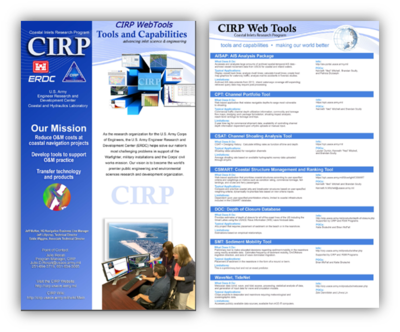
CIRP has been developing, field testing, and releasing tools that are accessible via web interfaces. These new products are summarized in a WebTools Brochure that was completed in September 2016. The WebTools Brochure provides an overview of the tools, describes applications and limitations, sources of information, and gives POCs. CIRP also has a numerical model brochure that similarly describe CIRP-funded numerical modelling technologies; both of these brochures are available on the CIRP website, http://cirp.usace.army.mil under Publications | Brochures.
POC: (ERDC) Julie Rosati, Julie.D.Rosati@usace.army.mil
Long-term morphodynamic modeling of barrier tidal inlets
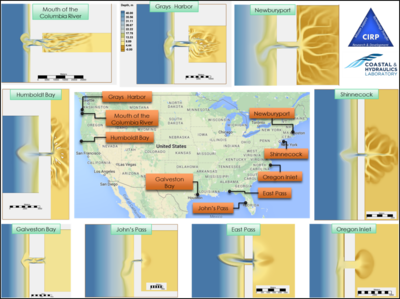
Given the potential long-term effects of global climate change, the USACE is developing procedures to incorporate sea level (SL) rise projections into planning, engineering design, construction, and operations of CW projects. In coastal settings, barrier island processes including sediment budgets, shoreline change, and channel stability will be impacted in ways difficult to predict by the physical effects of long-term, regional climatic change. Morphodynamic models provide the means to quantify these processes and can generate an array of forecast alternatives to support SMART planning and project development activities.
The Coastal Modeling System (CMS) developed by CIRP is used to simulate the long-term morphodynamics of coastal barrier-inlet systems. The CMS consists of an integrated numerical modeling system for simulating wave, current, water levels, sediment transport and morphology change. The long-term morphodynamic modeling work unit is conducting research to assess CMS as an engineering tool to investigate long-term changes to inlets and bays for decision support in CW projects. The initial phase of this study is to conduct idealized simulations of nine barrier island tidal inlets with dimensions similar to that of US inlet/bay systems for periods of 100 years (see figure). The results indicate that the model reproduces the generic features of the inlet, bay and ebb shoal morphology and the long-term predictions are in agreement with established barrier inlet stability theory. The results further demonstrate the feasibility of applying CMS for simulating long-term morphology at coastal inlets for practical applications. The next phase will demonstrate CMS's capabilities by simulating long-term morphodynamics of real inlet systems. This phase will be completed in FY17 and produce testing scenarios to examine the effects of SL rise in a major US port. The model will first be validated with historical data and then used to examine possible system changes under various SL rise scenarios. This approach will help elucidate system sensitivity to the effects of SL change and form a central component of the decision making framework.
Paper: Styles, R., M. Brown, K. Brutsché, H. Li, T. Beck, and A. Sanchez, 2016: Long-term modeling of barrier island tidal inlets, J. Mar. Sci. and Eng., 4, 65. http://www.mdpi.com/2077-1312/4/4/65/htm
POC: (ERDC) Richard Styles, richard.styles@usace.army.mil
POC: (ERDC) Mitchell Brown, mitchell.e.brown@usace.army.mil
USACE, ASBPA, and Other Feds Expand Coastal Dune R&D to Fund Six Academic Research Proposals Totaling $265,672
As discussed in previous CIRP webinars, Research Area Review Group meetings, and CIRP eNewsletters, Dr. Kate Brodie with colleagues Nick Spore (CHL-FRF), Dr. Meg Palmsten (Naval Research Laboratory), and Ian Conery (East Carolina University) have led CIRP Coastal Dune Research for the past three years utilizing 30 years of historical data on dune evolution along with ongoing pre- and post-storm measurements in the vicinity of the Field Research Facility at Duck, NC. Through collaboration with the American Shore and Beach Preservation Association (ASBPA), ERDC research has expanded to include other federal agency and academic partners to address management challenges for managing dunes on developed coasts. These 1-year academic research projects total $265,672 and were initiated in September 2016 as summarized next.
- Oregon State University’s (OSU) “Dune Evolution on Managed Coasts: Policy Options” will expand a process-based numerical modeling system for coastal dunes to include management options such as vegetation planting, beach nourishment, and beach scraping.
- University of North Carolina’s (UNC) “Modeling Dune Growth on Managed Coasts” will leverage OSU’s study together with time series observations of dune topography, vegetation cover, and wind data for a 25-km coastal reach in NC to advance a numerical dune evolution model and provide a database with which to calibrate and test models of vegetation growth and aeolian transport.
- University of Pennsylvania’s (UPenn), “Wind Tunnel Analyses of Vegetation Species…,” will build a moveable bed wind tunnel to test the sand-capturing capability of five types of foredune vegetation, and develop predictive technology.
- North Carolina State University’s (NCSU), “Development of Dune Design Criteria for Overtopping Considering Constructed Beach Berm,” will develop dune construction guidance for projects where a constructed beach berm affects the runup and overtopping elevation.
- Texas A&M University’s (TAMU), “Perceptions, Governance and Stakeholder Relationships along the Texas Coast,” will evaluate local stakeholder perceptions and management to improve the relevance and quality of technical analyses as related to coastal dunes.
- University of Alabama’s (UA), “Estimating Coastal Dune Vulnerability to Storms,” will evaluate the vulnerability of dunes to multiple storms, to test and refine predictive tools. Each academic institution has leveraged their research with federal and local agencies and non-governmental organizations. Research products will be communicated within the community of practice to facilitate rapid advancements in technology and management, and presented at ASBPA’s Fall 2017 Conference.
POC: (ERDC) Julie Rosati, Julie.D.Rosati@usace.army.mil
Dredging/Placement Features in Coastal Modeling System (CMS)
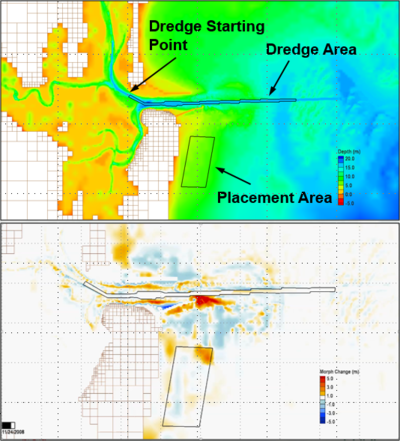
Dredging/placement operations have been incorporated into simulations of coastal morphological features in the Coastal Modeling System (CMS). Dredging is one of the primary missions of USACE. Several hundred million cubic yards of sediment are dredged annually from U.S. ports, harbors, and navigation channels to maintain and improve the Nation's navigation system for commercial, national defense and recreational purposes. Dredging operations can have a significant impact on coastal morphological evolution. Hence, the simulation of the coastal morphological features should also include dredging activities. In the past, dredging activities have been incorporated into CMS modeling studies by (1) interrupting the CMS simulation and modifying the bathymetry according to dredging activities and reinitializing the simulation or (2) limiting the simulation period to be within the dredging cycles. To accurately simulate long-term coastal morphology change extending over multiple dredging cycles, a Dredging Module (DM) has been developed and implemented in the CMS. The module directly simulates dredging operations by removing and adding sediment to user-specified dredge and placement areas. Model options are provided for how a dredging event is triggered and how material is dredged and placed. The DM in the CMS will significantly enhance the capability of the model to support the USACE dredging operations at navigation channels. Directly simulating multiple dredging cycles and morphological feedback within a CMS simulation will allow users to evaluate the morphologic changes due to dredging operations and estimate future dredging requirements in response to system modifications or changes in environmental forcing. The latest version of CMS can be downloaded from the CIRP website: http://cirp.usace.army.mil/products/cms.php. For more information about the latest CMS advancements, contact one of the POCs.
POC: (ERDC) Honghai Li, Honghai.Li@usace.army.mil
POC: (ERDC) Chris Massey, Chris.Massey@usace.army.mil
POC: (ERDC) Mitch Brown, Mitchell.E.Brown@usace.army.mil
Engineer Research & Development Center
3909 Halls Ferry Road, Coastal & Hydraulics Laboratory
Vicksburg, MS 39180
202-761-1850